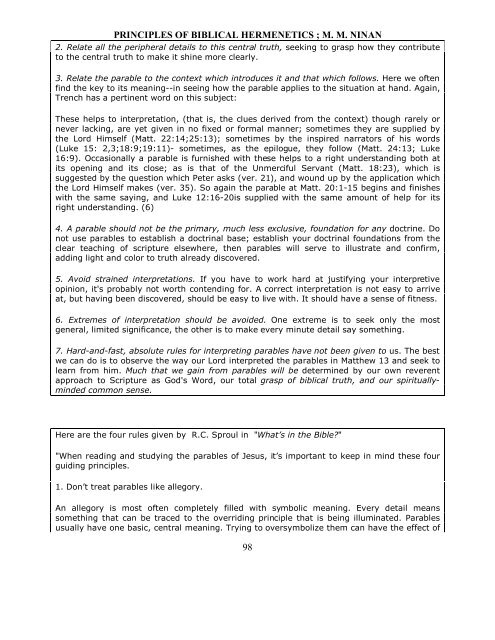Biblical Hermeneutics
You also want an ePaper? Increase the reach of your titles
YUMPU automatically turns print PDFs into web optimized ePapers that Google loves.
PRINCIPLES OF BIBLICAL HERMENETICS ; M. M. NINAN<br />
2. Relate all the peripheral details to this central truth, seeking to grasp how they contribute<br />
to the central truth to make it shine more clearly.<br />
3. Relate the parable to the context which introduces it and that which follows. Here we often<br />
find the key to its meaning--in seeing how the parable applies to the situation at hand. Again,<br />
Trench has a pertinent word on this subject:<br />
These helps to interpretation, (that is, the clues derived from the context) though rarely or<br />
never lacking, are yet given in no fixed or formal manner; sometimes they are supplied by<br />
the Lord Himself (Matt. 22:14;25:13); sometimes by the inspired narrators of his words<br />
(Luke 15: 2,3;18:9;19:11)- sometimes, as the epilogue, they follow (Matt. 24:13; Luke<br />
16:9). Occasionally a parable is furnished with these helps to a right understanding both at<br />
its opening and its close; as is that of the Unmerciful Servant (Matt. 18:23), which is<br />
suggested by the question which Peter asks (ver. 21), and wound up by the application which<br />
the Lord Himself makes (ver. 35). So again the parable at Matt. 20:1-15 begins and finishes<br />
with the same saying, and Luke 12:16-20is supplied with the same amount of help for its<br />
right understanding. (6)<br />
4. A parable should not be the primary, much less exclusive, foundation for any doctrine. Do<br />
not use parables to establish a doctrinal base; establish your doctrinal foundations from the<br />
clear teaching of scripture elsewhere, then parables will serve to illustrate and confirm,<br />
adding light and color to truth already discovered.<br />
5. Avoid strained interpretations. If you have to work hard at justifying your interpretive<br />
opinion, it's probably not worth contending for. A correct interpretation is not easy to arrive<br />
at, but having been discovered, should be easy to live with. It should have a sense of fitness.<br />
6. Extremes of interpretation should be avoided. One extreme is to seek only the most<br />
general, limited significance, the other is to make every minute detail say something.<br />
7. Hard-and-fast, absolute rules for interpreting parables have not been given to us. The best<br />
we can do is to observe the way our Lord interpreted the parables in Matthew 13 and seek to<br />
learn from him. Much that we gain from parables will be determined by our own reverent<br />
approach to Scripture as God's Word, our total grasp of biblical truth, and our spirituallyminded<br />
common sense.<br />
Here are the four rules given by R.C. Sproul in "What’s in the Bible?"<br />
"When reading and studying the parables of Jesus, it’s important to keep in mind these four<br />
guiding principles.<br />
1. Don’t treat parables like allegory.<br />
An allegory is most often completely filled with symbolic meaning. Every detail means<br />
something that can be traced to the overriding principle that is being illuminated. Parables<br />
usually have one basic, central meaning. Trying to oversymbolize them can have the effect of<br />
98


















